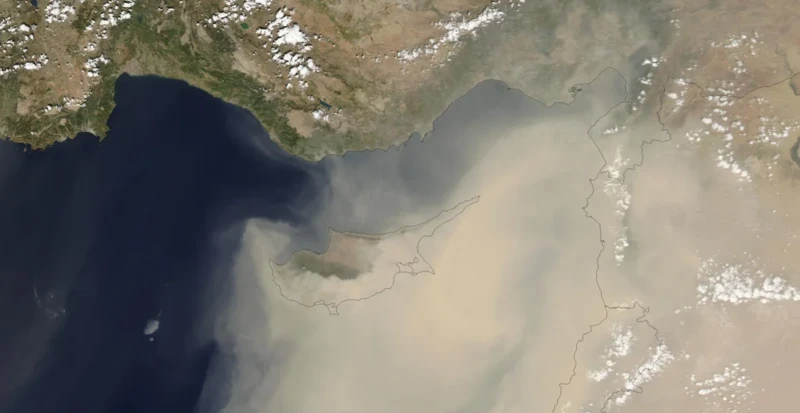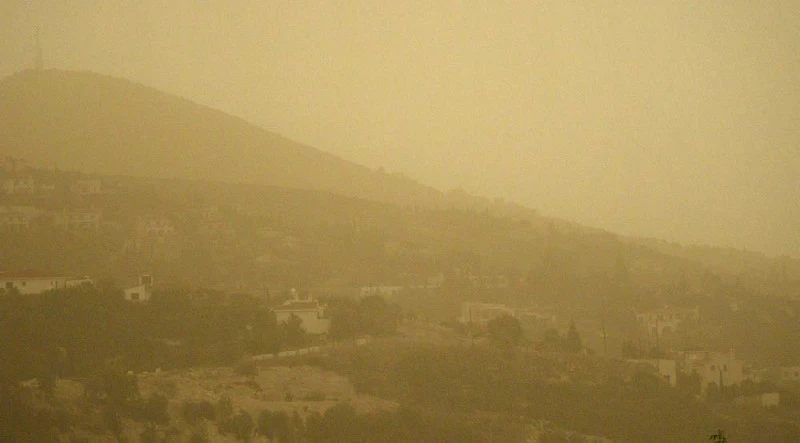How to behave during a dust storm?
Sandstorms in Northern Cyprus are not uncommon, although they are slightly less intense than in the southern part of the island.
Here are some recommendations on how to stay safe during such an event.
- Origin of dust storms in Northern Cyprus
- Health risks of dust storms
- Recommendations during a dust storm
- Frequently asked questions about dust storms

Origin of dust storms in Northern Cyprus
The island’s location makes it vulnerable — Cyprus experiences dust storms mainly due to its geographical proximity to the Sahara Desert in North Africa, although sometimes dust masses also travel from eastern deserts.
These dust storms occur when strong winds, such as the Sirocco or Khamsin, carry fine dust particles from the Sahara Desert across the Mediterranean Sea to Cyprus. This phenomenon is often influenced by low atmospheric pressure and warm airflows that facilitate the movement of dust.
Health risks of dust storms
The dust particles carried by these winds can significantly reduce air quality and visibility, posing health risks to residents, especially those with respiratory conditions.
Besides the obvious breathing problems, dust storms can cause irritation of the eyes and skin.
Recommendations during a dust storm
If indoors
- Close windows and doors: ensure your home or building is tightly sealed to prevent dust and sand from entering.
- Use air conditioning: if possible, turn on your air conditioner in recirculation mode to filter the air. If you have an air purifier with a HEPA filter, use it.
- Cover your nose and mouth: use a mask or a damp cloth to minimize inhalation of dust.
- Follow local news and weather forecasts to stay informed about the storm’s development.
If outdoors
- Find shelter to protect yourself from wind and flying debris.
- Protect your head: use your hands, backpack, or any available item to shield your head.
- Be aware of your surroundings: watch out for flying debris and potential hazards.
If driving
- Gradually reduce speed, turn on hazard lights, and pull as far over to the side as possible.
- If visibility is severely reduced, it’s best to stop.
- Stay inside the vehicle with windows and doors closed and air conditioning in recirculation mode.
- Do not leave the vehicle: besides dust, there may be flying debris outside.
Whether indoors or outdoors during a sandstorm, outdoor physical activities are strictly prohibited. During exercise, the body needs more oxygen, leading to more intense breathing and, consequently, increased inhalation of dust particles.
If you have respiratory issues, take extra precautions to avoid inhaling dust particles. For example, you can use a construction respirator.
Symptoms requiring immediate medical attention:
- difficulty breathing;
- extreme fatigue;
- wheezing when breathing.

Frequently asked questions about dust storms in Northern Cyprus
Where can I find an air pollution map?
Unfortunately, such a map is available only for the southern part of Cyprus, and it can be found at this link. However, residents of northern Nicosia can also make use of it.
When was the strongest dust storm in Northern Cyprus?
One of the strongest dust storms across the entire island of Cyprus occurred in early April 2022. It was recognized as one of the most intense in the past twenty years.
When do dust storms most frequently occur in Northern Cyprus?
Historically, the most intense dust phenomena across Cyprus have occurred in April and May. However, in recent years, such events have become more frequent and are now observed in other months as well.
Which other countries are affected by dust storms?
After passing over Cyprus, dust clouds can sometimes reach Central Europe if wind conditions are favorable. However, besides Cyprus, Greece and Italy are the most frequently affected countries by Saharan dust.
Follow us on Instagram and Telegram — we share the most useful tips about Northern Cyprus!

